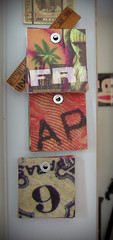Want to know who your friends and neighbors are supporting? Here's a site that has calculations based on records filed with the FEC of contributions by all individuals totalling more than $200 (and some totalling less than $200) to a single Republican or Democratic presidential campaign or national committee between January 1, 2003 and July 31, 2004.
They gave how much to who?
That's Right,
HMK
Friday, August 27, 2004
How Cool Is That!
Internet machine shop offers custom tooling.
It's the Internet Revolution meets the Industrial Revolution: a new program that lets people design 3-D objects like car parts and door knobs in metal or plastic then order them online.
Programs for computer-aided design, or CAD, have been around for decades, but eMachineShop.com appears to be the first service that checks whether a design can be made, tells the customer how much it will cost. If the customer wants the item the design goes to a "real world" machine shop for manufacturing.
The key to this enterprise is free design software provided by eMachineShop that aims to be simple enough for hobbyists and other non-engineers.
Prices won't be competitive with Wal-Mart, but Wal-Mart won't make ten copper door knobs, then sandblast them for you. EmachineShop charges $143 for that.
The company was created by Jim Lewis, a programmer and self-professed "tinkerer." One previous credit: "the world's hardest sliding block puzzle."
Even though the Midland Park, New Jersey, company, which has 19 employees, doesn't advertise, it has handled more than 1,000 orders for things like door signs, motorcycle seats, robot frames, car engine covers, guitar plates and camera parts.
The most expensive item it's sold since it began beta testing last year is a $4,011 aluminum, 26-inch diameter part for a high-powered laboratory magnet.
The customers range from large companies that make prototypes to hobbyists including Dennis J. Vegh of Mesa, Arizona, who had the company make metal parts for an airplane he's building after a 1929 design.
"I had to have the pieces made because they do not exist anywhere," Vegh said.
He found the software quick and easy to use. The quality of the finishing has varied a bit between orders, but has been acceptable, he said.
"Being able to sit at you home computer, draw up some parts, submit them and 30 days later they are on your doorstep, all without human contact, is mind-blowing," Vegh says.
Merging design and manufacturing
EMachineShop.com provides software that companies can use to design machine parts on a computer and have them manufactured.
Lewis, the company founder, estimates that with conventional methods, it takes about 40 hours to design a part, get a quote, straighten out manufacturing problems with the machine shop and put the order in.
Taylan Altan, professor at the College of Engineering at Ohio State University, agrees, saying the process can easily drag out to two weeks.
"One of the biggest problems we have today in American design and manufacturing is that designers know very little about manufacturing," he says.
As a result, designers draw parts that are hard to make and require several rounds of modification before they can be put in production, a problem eMachineShop aims to avoid by building the knowledge of a machinist into the design software.
For instance, if you're designing a part made of sheet metal, it won't allow you to include a bend too close to an edge -- the machinist needs enough surface to hold on to when bending.
Lewis is also working on Pad2Pad, an application that makes electronics. Manufacturers of printed circuit boards, like PCBExpress.com, are already online but Lewis aims to take the concept one step further by also attaching components like resistors, capacitors and chips to the boards.
Pad2Pad is taking orders, but is "a couple of years behind eMachineShop" in its development, Lewis says. One problem is stocking the components customers want.
Lewis also wants into branch into what is perhaps the least sexy segment of manufacturing: making cardboard boxes for packaging.
"My dream is essentially to become the Amazon in the manufacturing segment," Lewis says.
It's the Internet Revolution meets the Industrial Revolution: a new program that lets people design 3-D objects like car parts and door knobs in metal or plastic then order them online.
Programs for computer-aided design, or CAD, have been around for decades, but eMachineShop.com appears to be the first service that checks whether a design can be made, tells the customer how much it will cost. If the customer wants the item the design goes to a "real world" machine shop for manufacturing.
The key to this enterprise is free design software provided by eMachineShop that aims to be simple enough for hobbyists and other non-engineers.
Prices won't be competitive with Wal-Mart, but Wal-Mart won't make ten copper door knobs, then sandblast them for you. EmachineShop charges $143 for that.
The company was created by Jim Lewis, a programmer and self-professed "tinkerer." One previous credit: "the world's hardest sliding block puzzle."
Even though the Midland Park, New Jersey, company, which has 19 employees, doesn't advertise, it has handled more than 1,000 orders for things like door signs, motorcycle seats, robot frames, car engine covers, guitar plates and camera parts.
The most expensive item it's sold since it began beta testing last year is a $4,011 aluminum, 26-inch diameter part for a high-powered laboratory magnet.
The customers range from large companies that make prototypes to hobbyists including Dennis J. Vegh of Mesa, Arizona, who had the company make metal parts for an airplane he's building after a 1929 design.
"I had to have the pieces made because they do not exist anywhere," Vegh said.
He found the software quick and easy to use. The quality of the finishing has varied a bit between orders, but has been acceptable, he said.
"Being able to sit at you home computer, draw up some parts, submit them and 30 days later they are on your doorstep, all without human contact, is mind-blowing," Vegh says.
Merging design and manufacturing
EMachineShop.com provides software that companies can use to design machine parts on a computer and have them manufactured.
Lewis, the company founder, estimates that with conventional methods, it takes about 40 hours to design a part, get a quote, straighten out manufacturing problems with the machine shop and put the order in.
Taylan Altan, professor at the College of Engineering at Ohio State University, agrees, saying the process can easily drag out to two weeks.
"One of the biggest problems we have today in American design and manufacturing is that designers know very little about manufacturing," he says.
As a result, designers draw parts that are hard to make and require several rounds of modification before they can be put in production, a problem eMachineShop aims to avoid by building the knowledge of a machinist into the design software.
For instance, if you're designing a part made of sheet metal, it won't allow you to include a bend too close to an edge -- the machinist needs enough surface to hold on to when bending.
Lewis is also working on Pad2Pad, an application that makes electronics. Manufacturers of printed circuit boards, like PCBExpress.com, are already online but Lewis aims to take the concept one step further by also attaching components like resistors, capacitors and chips to the boards.
Pad2Pad is taking orders, but is "a couple of years behind eMachineShop" in its development, Lewis says. One problem is stocking the components customers want.
Lewis also wants into branch into what is perhaps the least sexy segment of manufacturing: making cardboard boxes for packaging.
"My dream is essentially to become the Amazon in the manufacturing segment," Lewis says.
Subscribe to:
Comments (Atom)




























































